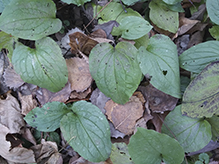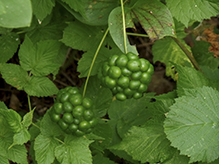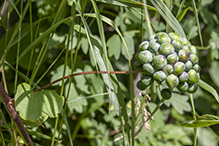Blue Ridge carrionflower
(Smilax lasioneura)
Conservation • Description • Habitat • Ecology • Use • Distribution • Taxonomy
|
|
|||||||||||||
Description |
Blue Ridge carrionflower is an annual, non-woody (herbaceous), climbing vine that rises from a rhizome. It is the most common and widespread species of Smilax in Minnesota. The stems are green and almost always branched. They extend up to 80″ to 100″ in length. They are soft and easily crushed between fingers, even when dry. They are not armed with bristles or prickles. Young stems are erect or ascending. Mature stems are climbing. There are more than 25 leaves on a mature stem. The leaves are alternate and deciduous, and are distributed evenly on the stem. They are on hairless, ⅝″ to 3½″ long leaf stalks (petioles) that are shorter than the leaf blades. Nearly every leaf axil bears a pair of long, conspicuously curled tendrils that cling to adjacent plants or structures for support. The leaf blades are narrowly to broadly egg-shaped or nearly round, 1½″ to 3½″ long, and 1¼″ to 2⅜″ wide. They are wedge-shaped or shallowly heart-shaped at the base. The leaf tips may be broadly rounded; tapered with convex sides along the tip; or rounded with a short, sharp, abrupt point, at the tip. The upper surface is green, hairless, and not shiny. The lower surface is light green or grayish-green, not shiny, and often somewhat covered with a whitish, waxy coating (glaucous). The veins on the underside are sparsely to densely covered with minute, transparent, flattened hairs. The margins are untoothed and is not thickened. There are 3, 5, or 7 conspicuous veins that arch from the base of the leaf blade and converge toward the tip. The inflorescence is a globe-shaped, umbrella-like cluster (umbel) of up to 35 flowers rising singly from middle and upper leaf axils. Each stem may have several umbels. The stalk of the umbel (peduncle) is 2″ to 4¾″ long, 1 to 5 times as long as the petiole of the subtending leaf. Each umbel is about 3½″ in diameter and has up to 35 flowers. Male and female flowers are borne on separate plants. There are 3 green to greenish-yellow, strap-shaped, 1⅜″ to 1¾″ long petals and 3 similar sepals (6 tepals). The male flowers have 6 stamens with yellow anthers. They appear in May to June. The fruit is a dark blue to nearly black, glaucous, globular berry, 5 ⁄16″ to ⅜″ in diameter. |
Height |
Climbing vine: 80″ to 100″ in length |
Flower Color |
Green to yellowish-green |
Similar Species |
Habitat |
Moist. Woodlands, woodland borders and openings, thickets, fencerows, roadsides, and other open areas. Full or partial sun. |
Ecology |
Flowering |
May to June |
Pests and Diseases |
|
Use |
|
Distribution |
||
|
Sources |
|
| 7/4/2025 | ||
Nativity |
||
Native |
||
Occurrence |
||
Common and widespread |
||
Taxonomy |
|
Kingdom |
|
Division |
Tracheophyta (Vascular Plants) |
Subdivision |
Spermatophytina (Seed Plants) |
Class |
Liliopsida (Monocots) |
Order |
Liliales (lilies, supplejacks, and allies) |
Family |
Smilacaceae (greenbrier) |
Genus |
Smilax (greenbriars) |
Section |
Nemexia (carrionflowers) |
Genus Species epithet Adjectives in Latin must agree with the noun they modify in gender, number, and case. This means that the ending of the adjective must change to match the gender of the noun. The original description of the species in Latin is in Flora Boreali-Americana 2 by William Jackson Hooker published in 1840. Hooker used the spelling “S. lasioneuron”, in which the species epithet does not agree with the gender of the genus. In the same genus, he described S. rotundifolia, in which the species epithet does agree with the gender of the genus. This indicates that his use of “lasioneuron” is an obvious misspelling. Today, almost all sources use the corrected spelling “lasioneura”. Plants of the World Online and iNaturalist use the original spelling “lasioneuron”. |
|
Subordinate Taxa |
|
|
|
Synonyms |
|
Nemexia lasioneura Smilax herbacea var. lasioneura Smilax lasioneuron |
|
Common Names |
|
Blue Ridge carrion-flower Blue Ridge carrionflower common carrion flower hairy carrion-flower midwestern carrionflower |
|
Glossary
Axil
The upper angle where a branch, stem, leaf stalk, or vein diverges.
Bract
Modified leaf at the base of a flower stalk, flower cluster, or inflorescence.
Glaucous
Pale green or bluish gray due to a whitish, powdery or waxy film, as on a plum or a grape.
Herbaceous
Not woody. A plant without a persistent, above-ground, woody stem, with the leaves and stems usually dying back to the ground at the end of the growing season.
Peduncle
In angiosperms, the stalk of a single flower or a flower cluster; in club mosses, the stalk of a strobilus or a group of strobili.
Petiole
On plants: The stalk of a leaf blade or a compound leaf that attaches it to the stem. On ants and wasps: The constricted first one or two segments of the rear part of the body.
Rhizome
A horizontal, usually underground stem. It serves as a reproductive structure, producing roots below and shoots above at the nodes.
Sepal
An outer floral leaf, usually green but sometimes colored, at the base of a flower.
Tepal
Refers to both the petals and the sepals of a flower when they are similar in appearance and difficult to tell apart. Tepals are common in lilies and tulips.
Umbel
A flat-topped or convex, umbrella-shaped cluster of flowers or buds arising from more or less a single point.
Visitor Photos |
||
Share your photo of this plant. |
||
This button not working for you? |
||
Dan W. Andree |
||
 |
||
Vine like plant with light green... berries or whatever they are in a clump. It was in with some small shrubs, other kinds of vines, poison ivy etc. Has somewhat heart shaped leaves first time I seen it. I just seen it today. Here is a small image of part of it. Will send a larger one once I go through and see how much of the plant shows. It was in dense vegetation at Frenchman's. |
Larger vine like plant.... This plant climbed upward but something ate the leaves off. It also climbed downward as you can see and goes to the lower left corner. Those berries were on the vine. I looked. There were a few more I seen but they didn't have those berries or whatever they are on them that I could see. Leaves etc. the same. |
|
Luciearl |
||
 |
 |
|
August and September pic of same plant. |
||
 |
 |
|
August... |
August... |
|
 |
||
...then ripening in Sept. |
||
Bill Reynolds |
||
 |
 |
|
 |
||
MinnesotaSeasons.com Photos |
||
 |
||
Vine |
|
|
 |
 |
|
Vine |
Vine |
|
 |
 |
|
Leaves |
Leaves |
|
 |
 |
|
Infructescence |
||
|
||
|
||
|
Fruit |

Slideshows |
|

Visitor Videos |
||
Share your video of this plant. |
||
This button not working for you? |
||
|
Other Videos |
||
|

Visitor Sightings |
||
Report a sighting of this plant. |
||
This button not working for you? |
||
Sherry Baker |
Location: Henryetta OKLAHOMA |
| Luciearl 11/10/2021 |
Location: Lake Shore |
 |
| Luciearl August and September 2018 |
Location: Lake Shore, MN |
 |
| Bill Reynolds 9/11/2014 |
Location: Pennington Co. |
 |
| Bill Reynolds 10/11/2013 |
Location: Pennington Co. |
 |
MinnesotaSeasons.com Sightings |
||

|
Created: 10/13/2013 Last Updated: © MinnesotaSeasons.com. All rights reserved. |



